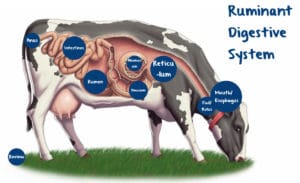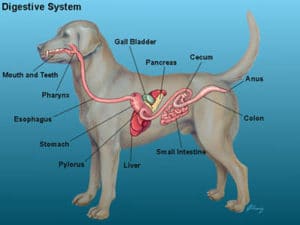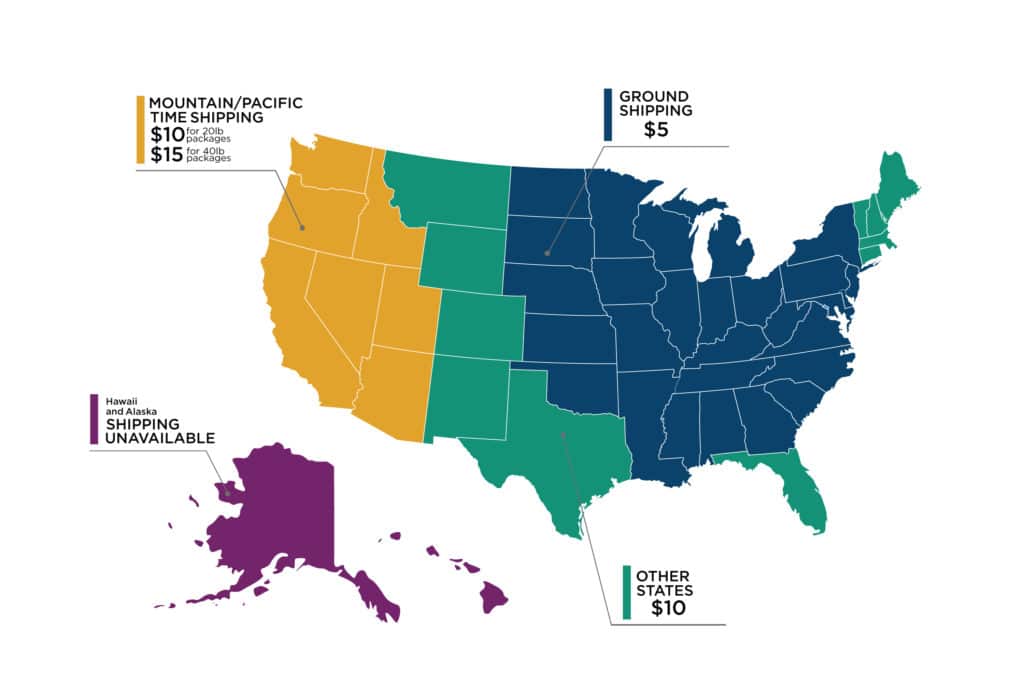FAQ
Family
We are a family owned and operated business in Zeeland Michigan. We know nutrition is extremely important for overall health and wellness for all our family members including the four-legged kind. We are passionate about what we do and have been blessed to work alongside our 4 sons.Service
Customer service is our top priority here at Great Lakes Pet Food. We strive to answer all your questions quickly. As a small company we understand the value in relationships with our costumers. Do not be surprised if you actually receive a real phone call from our CEO regarding your questions. Never hesitate to contact us!Quality
We take pride in bringing you the very best products for the furry members of your family. We knew our dogs deserved the very best so we set out to create a food line that provided them with superior nutrition. Quality ingredients are the foundation of our kibble.Trust
We are grateful for each one of our customers, and honored that you trust us to feed your best friend. We will continue to work hard and create products you can trust. Our honest approach to nutrition and health will always put your dog first.Our products are the real deal. We actually tell it the way it is. We don't expect you to trust us, so we explain why we do what we do. We give you real information and science that you can then verify and logically think through. Thus you can form your own opinion. Be careful of studies and theories that contradict the anatomical makeup of your dog. Most of these studies have money-making in mind and not the health of your dog. You don't need a college degree to understand the genetic makeup of your dog and their digestion needs. Please take the time to read our frequently asked questions.
Why puppy to adult
Did you know, by the time you pick up your puppy they are equivalent to a toddler? Young children eat the same quality food as mom and dad. So, we feel quality food shouldn't stop at the puppy stage. Your dog deserves high quality food for life.
The simplest answer is that dogs were not made to eat grain. Naturally, dogs are meat-eating animals. Dogs have hydrochloric acid in their stomachs that is 10-times more powerful than a human. They also have the shortest gastrointestinal tract of all mammals in the animal kingdom.
These are the main reasons dogs can eat raw or rotting meat and not get sick.
Grain eating animals do not have the same anatomy as dogs. A grain eating animal of comparable size have digestive tracts eight times longer than a dog. They have different enzymes and bacteria to digest grains that dogs don't have.
Feeding your dog grain will stress their immune system since it’s not what their body needs. This, therefore, opens the door for a multitude of diseases, allergies, and sensitivities. On top of weakening their immune system, your dog will not be able to extract the proper nutrients from the grains because they are not designed to. By choosing a grain-free product, you allow your dog optimal nutrition they were designed to eat and digest. We encourage you to make the switch and choose grain-free for your dog!
Nature: We know a dogs genealogy starts with wolves. We also know wolves eat farmer's livestock and not the grain. So, why feed dogs grain when they wouldn't naturally eat it? Dog food companies choose grain because it's a cheap filler in which the dogs will eat more of, which increases sales. Feeding grain is about making money and not because it is good for your dog.
Body: Roughly 70-80% of your immune system is located in your gut. This is also true of your dog. Therefore, keeping the gut healthy is key to illness prevention.
Choice: We all know there can be side effects to eating unhealthy, and grain puts unnecessary gut stress on your dog. Help your dog thrive by feeding Great Lakes Pet Food, a choice that is completely grain free.
Bottom Line: Our products are the REAL DEAL. If you have questions, we will tell it to you straight, like it is, no holds barred.


LOGIC 101: The Anti-Grain Free Propaganda
We would like to present the evidence and let you decide.
There is a growing concern about dogs developing dilated cardiomyopathy (DCM), which means an enlarged heart. "Between January 2014 and April 30, 2019, the FDA received 524 reports of DCM, including 119 dog deaths and five cat fatalities. Of those reports, 222 of them came between Dec. 1, 2018, and the end of April, the agency said." (Gibson, 2019)
Be aware that there was no official study that had a control group versus a test group, meaning there was no true way to know what caused the heart issues in these dogs. If these people have no true way of knowing what is causing DCM, why blame grain-free? Read more and find out!
How many dogs are affected by this?
The Math: This article is using a 5-year number of 524 dogs. So how many dogs are represented in these 5 years? We know the United States has approximately 80 million dogs in any given year. So 80 million x 5 years = 400 million dogs. This means your dog has a .00000131% chance of having a problem or a 1 out of 763,358 chance of developing a problem. We also have to remember that most of the dogs getting sick or dying were breeds already predisposed to having DCM. – The math doesn’t advocate the anti-grain free propaganda, so what is the real issue?
Why publish these reports?
The Reason: Dogs eating grain-free will eat almost half as much kibble, this means pet food companies sell almost half as much kibble. Also, the amount of money made per bag is less with grain-free kibble. So, not only do they lose out on the amount they sell, but they are also losing out on how much they make per bag. I can tell you as an owner of a pet food company, this grain-free movement is costing the big boys in the pet industry a lot of money. No one wants their paycheck to be cut in half.
Who did this reporting?
The Mystery: It is not stated who did the reporting for the articles. These names were not all made known – Very suspicious. From our research, the reporting came from veterinarians which most, if not all, receive benefits from selling and advising a grain-based kibble – Again, suspicious.
Was there an actual study?
The Crazy: There has never been an actual study conducted. There have only been opinions that stated maybe’s, might’s, potential’s, possibilities that were written to seem factual. There was nothing definitive or conclusive.
Who is funding these reports?
The Hush Hush Secret: We have all witnessed 3rd party reporting that seems to be legit, except that it turns out big businesses are funding it for their own agenda. In this case, two big companies won’t be named funded and pushed the reports. We are all wising up to false narratives.
What’s not talked about?
The Elephant In The Room: The dog’s digestive system is not designed to digest grains. Dogs are not cows! Dogs are made to digest meats and fats. Unfortunately, the real issue isn't addressed because too much money is made by feeding dogs grain.
What can we compare this too?
The Perspective: Not many people thought fast food was bad for you in the ’80s and ’90s. It was cheap, tasted good, and very convenient. We all know better now. People are more knowledgeable about what they eat, so it’s only logical that this would carry over to their dogs.
What have we done?
Being Proactive: Many actual studies have been done stating the positive effects of taurine in your dog’s diet. One of the biggest positive affects is aiding in heart health. It has been so positive that it has even been shown to reverse dilated cardiomyopathy (enlarged heart).
We make sure the dogs are receiving enough taurine in two ways. 1st - providing meat-based kibble is the natural way because taurine naturally occurs in meat. 2nd - we add more taurine into our dog food. These two things ensure your dog has its nutritional needs met.
What will we do?
The Outcome: We will remove any ingredient that is proven to be bad for your dog. We won’t hesitate, blink, or procrastinate – a change would be made the same day.
What can you do?
Your Stance: Don't be pushed around and pressured into doing what big business/big government wants you to do. Be your own person and make your own decisions.
Source: Gibson, Kate. “16 dog food brands may cause heart disease in pets, FDA warns” CBS News, July 1st 2019, https://www.cbsnews.com/news/dog-food-and-heart-disease-fda-warns-16-dog-food-brands-may-cause-heart-disease-in-pets/
https://www.petbusiness.com/business-and-marketing/the-latest-update-on-grain-free-foods-dcm/article_7b344b8c-4f5a-11eb-9f22-ab04d59c79d5.html?utm_medium=social&utm_source=email&utm_campaign=user-share
You will likely notice a change in how much your dog eats. This is due to the fact that your dog is able to better digest food that is grain-free. On average, dogs eat about 40% less on a grain-free diet. Ultimately, this means you’ll spend less on dog food over time since you will not need to purchase as much.
The costs may seem higher upfront due to meat and vegetables being more costly to produce, but the long-term will be more cost-effective and mean a healthier dog. Plus, less food will mean less poop for you to pick up and better stool for your dog since their digestive tract will be functioning properly, and who doesn’t want that?
Yes & No. The upfront cost of our food will be more. It costs more to produce meat and vegetables than it does to produce grain. The good news is that your dog will eat 40% less on average from grain based food. This means you can take 40% off the price when comparing. In addition, a healthy dog mean less trips to the vet! So don't be surprised if your vet speaks against a grain free diet.

Unfortunately, we are unable to ship to Alaska and Hawaii.
This is because the dog can actually digest the food that it is eating, thus the intestinal tract can extract nutritional value from the food. This does not happen with grain based foods. Our studies conclude that most dogs eat approximately 40% less of our food versus a grain filled diet on average. This is due to the fact that they are able to digest the food and therefore extract the nutritional value from it. They will also eat 1/2 as much once they are done growing.
Less Poop: Have you realized you’re not picking up as much poo? It’s because you are feeding them a nutritional food without the grain fillers. Your dog will be eating approximately 40% less and less going in means less coming out.
Less Smell: Your dog’s digestion tract will no longer be working overtime trying to digest grains, which it never fully does. When digestion isn’t complete, the food rots in the gut, producing a fouler smelling poop.
Better Stool: When everything is working properly, the stool will be nice and firm and the smell won't knock you over!
MADE IN THE USA! The kibble is made in the Great Lakes Region. The meat treats are made in Michigan from Michigan raised pigs. The treats are made in a USDA facility with USDA pork. It’s made right along side of people products making it human grade. Our family often snacks on the meat treats as quick on the go protein.
In order to meet the standards set forth by AAFCO, vitamins and minerals are added to ensure pets have what they need for complete and balanced nutrition for all life stages. Some minerals are not as easily digested so they are bound to amino acids, which are the building blocks of proteins, in a process called chelation. You may recognize them as the minerals that end in “ate.” These chelated minerals are better absorbed in the digestive system providing vital nutritional benefits. They may be hard to pronounce, but they are healthy for your pet.
Please click the Ingredient tab to view a glossary listing of each ingredient and how it benefits your pet.
It’s simple! Click on the pet food you wish to have delivered to you. Select the size bag you would like. Then click on the Autoship and save 5% button. From there you choose the delivery & billing schedule that works the best for you and your pet. Finally, add it to your cart. That’s it!
Note: All prices are subject to change without notice at any time.Yes, go to the My Account section > View Autoship. Click the autoshipment you would like to cancel. Under the actions section click the cancel button.
Note: All prices are subject to change without notice at any time.
To manage your autoshipment go to My Account> View autoship and click on the autoship you wish to make changes to. Under the actions section you can make changes. If you are unable to make the change you are looking for there, please email us at info@greatlakespetfood.com and we can make the change for you.
Note: All prices are subject to change without notice at any time.
You can change your delivery schedule by going to My Account> Autoship>View. In the Change Autoship Box you will see options to downgrade or upgrade your time of delivery.
When you sign up for our Autoship and Save program you will automatically receive 5% off of each bag of pet food.
Any pet food you receive from our Autoship and Save program will have the 5% discount applied to it. If you place an additional one-time order you will not receive the 5% off.
Of course! After you choose your desired Delivery & Billing schedule you can change the quantity of pet food before adding it to your cart.
Your credit card will be charged the same day your product is shipped out.
While the FDA (Food and Drug Administration) regulates the pet food industry in the United States, the Association of American Feed Controls Officials (AAFCO) is the non-profit organization that sets the standards for both animal feeds and pet foods in the U.S. Many States also have regulatory agencies overseeing food/feed manufacturing compliance. For the State of Michigan, that agency is MDARD: Michigan Department of Agriculture and Rural Development.
Once you receive your product, come back to the website, find the product, and submit a review. Once we approve that review you will get an email with a coupon code to use on the website. You will only receive ONE coupon per customer.
If you currently have a subscription product, simply email us when you would like to redeem your coupon and we will add it to your order. Your email must include the coupon code.
**This item is no longer available for purchase. However, if you have previously purchased and ID tag the lost and found program is still active.**
When you purchase your new puppy from a Great Lakes Pet Food affiliate breeder they will give you a blue Great Lakes Pet Food ID tag. This tag is an alternative lost and found program. It is great to use before your dog is microchipped or in place of microchipping. Here is how it works:
- Your breeder notifies us that you have purchased a puppy and what number ID tag you received.
- We enter the information into our customer data base.
- In the unfortunate situation that your puppy is ever lost, we have our phone number on the tag as well. Once we receive a call, we search our data base for the number, we call you with who has your dog and how to contact them and you get your puppy back.
- We do not accept returns on meat treats. If you have a meat treat that is unopened and is moldy, please send us a picture and we will replace it with 2.
- Simply ship it back to us (300 S. State St, Suite 12, Zeeland, MI 49464) and send us an email letting us know you are returning your product and why. Once your package is received you will have a full refund within 3-5 business days.
- Send us an email letting us know you are looking to do a return, the reason for your return, and that you would like us to provide you a shipping label. We will email you a return with the label and the expected return label fee. Once the package is received by us you will get a refund, minus the return label fee, within 3-5 business days.
